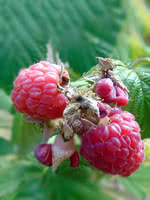Mon-Fri 9am - 5pm Mountain time
Wild Red Raspberry vs Bilberry
Vaccinium myrtillus
Rubus idaeus
CUSTOM GROW
Bilberry is a native perennial shrub valued for its small, blue-black berries that ripen in mid to late summer. The berries resemble blueberries but have a richer, more tart, and intense flavor. They have long been used for fresh eating, baking, and preserves, while also providing food for birds and mammals. In spring, its delicate pinkish flowers attract bees and other pollinators.
Growing low to the ground, Bilberry forms spreading colonies that create dense understory cover. This growth habit provides food and shelter for wildlife, and its foliage adds seasonal interest by turning red to purple in autumn. With its adaptability and ecological benefits, Bilberry is well-suited for naturalization, ecological restoration, and pollinator gardens.
The Wild Red Raspberry produces small, tart, red berries. They are delicious when eaten fresh, but also add flavor to preserves or desserts. They are highly suckering and can be high yielding.
The Wild Red Raspberry is also otherwise known as the American Red Raspberry, European Red Raspberry, Grayleaf Raspberry, or the Common Red Raspberry.
The Wild Red Raspberry are floricanes, primarily fruiting on second year canes. Each spring cut back all two-year old canes, leaving only the last year’s growth. This is a self-pollinating variety, so it doesn’t require a second plant nearby to set fruit.
Bilberry Quick Facts
Wild Red Raspberry Quick Facts
Toxicity: leaves may be unsafe in high doses

